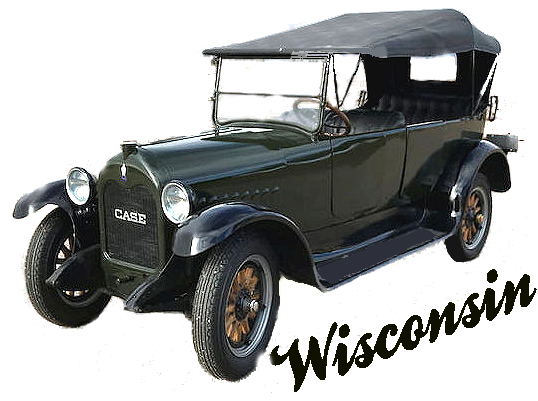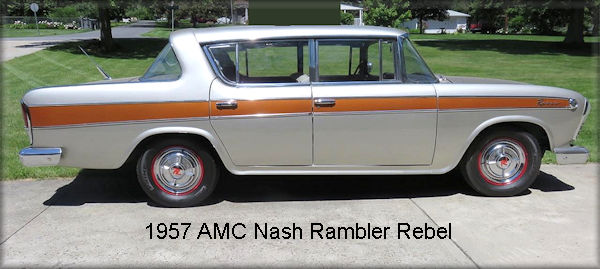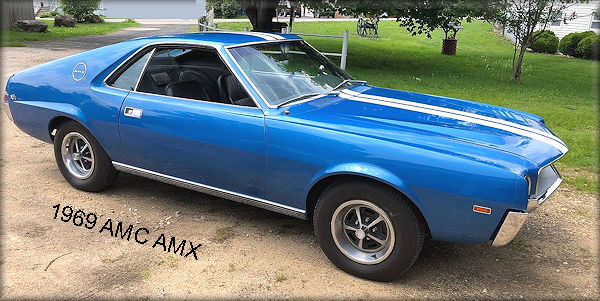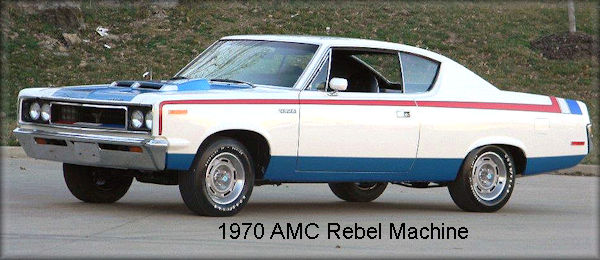



Mobile users:
For best results, view in Landscape mode.
In 1954, the Nash-Kelvinator Corporation
of Kenosha and Hudson Motor Car
Company merged to create the American
Motors Corporation (AMC), which
was the 4th biggest car company in
America until it was acquired by
Chrysler in 1987.
The term "Muscle car" is used to describe
a wide variety of powerful, high
performance cars.
Many muscle car enthusiasts believe the
1949 Oldsmobile Rocket 88 was the
first muscle car.
It boasted America's first overhead valve
V8 in a relatively light body, giving it a lot
of power and speed.
Muscle cars were originally referred to
as "Supercars", often spelled with a
capital S.
The 1957 Rambler Rebel, introduced
by American Motors Corporation (AMC)
of Kenosha, was the first mid-sized car
to be available with a big-block V8 engine.
The Rambler Rebel is credited for being
the first factory-produced mid-sized
high-performance car.
This later became known as the 'Muscle Car'
market segment.
It was also to be among the earliest
production cars equipped with electronic
fuel injection.

It might look like a standard 1950's sedan
with some fancy trim pieces, but this was
the 'Supercar' of the day.
It is considered to be the first true
muscle car in America with a 327 cu in
(5.4 L) V-8 engine producing 255 hp, 345-lb-ft,
its 0–60 mph acceleration of 7.5 seconds
made it the fastest stock American sedan
at the time.
Only the fuel-injected Chevrolet Corvette
beat it by half a second.
The 1957 Rambler Rebel was described
as a "potent mill turned the lightweight
Rambler into a veritable Supercar."
The powerful engine option raised the
price of an affordable Rambler.
So only a few buyers were ready to
pay extra for the privilege of outrunning
anything else on the road.
As a result, only 1,500 cars were produced.
From the mid-1960's to the mid-1970's,
"dragstrip bred" mid-size cars were
equipped with large, powerful V8 engines
and rear-wheel drive were referred to as
Supercars more often than muscle cars.
The Rambler Rebel was produced by
the American Motors Corporation (AMC)
of Kenosha for the 1957 - 1960 model
years, and again for 1966 - 1967.
Few people recognize AMC as a producer
of muscle cars, but AMC did in fact
make muscle cars to compete with the
likes of the Chevy Chevelle, Ford Torino,
and Dodge Charger.
The AMC AMX was produced from
1968 - 1970.
All AMXs came with 4-barrel carbureted
small block AMC V8 engines in several
versions: 290 cu in (4.8 L) (225 hp, N-code),
343 cu in (5.6 L) (290 hp, T-code), as well
as the 390 cu in (6.4 L) "AMX" featuring
315 hp with 425 ft lbs of torque.
For its first year recognition, the reasons
cited included the car's dashboard, which
was injection-molded in one piece
"for safety purposes, an industry first."
The AMX name originates from the
"American Motors experimental" code used
on a concept vehicle and then on 2
prototypes shown on the company's
"Project IV" automobile show tour in 1966.
The AMX was designed to "appeal to
both muscle car and sports car
enthusiasts".
The AMX was also classified as a muscle
car, but "unique among other American
cars at the time due its short wheelbase".
The AMX was also the only American steel
bodied 2-seater of its time, the first since
the 1955 - 1957 Ford Thunderbird.
To a degree, the AMX was a competitor
with America's only other 2-seater of the era,
the Chevrolet Corvette and much
more affordable.

Fitted with the optional high-compression
medium block 390 cu in (6.4 L) V8 315 hp,
with a 4-barrel carburetor.
It could go from 0-60 mph in 7.2 seconds.
The American Society of Automotive Engineers
named the AMX as the "best engineered
car of the year" in 1969 and 1970.
The Rebel Machine is one of the more
well known AMC models.
The car had the build of a proper muscle
car and when it came to its performance,
it did not disappoint despite weighing over
3,300 lbs.

The cars were powered by 390 cu in (6.4 L)
V-8 340 hp, 430 lbs. ft torque with a four
barrel carburetor.
There was also a big hood scoop that helped
suck air into the engine via a vacuum
controlled butterfly valve.
In 1970, the high-performance, low-priced
muscle car version was produced.
The Machine, that is most recognized in
its flamboyant white, red, and blue trim.
The Rebel was manufactured in Kenosha
and in Brampton, Ontario, Canada.
The Rebel Machine was produced for
only 1 year.
